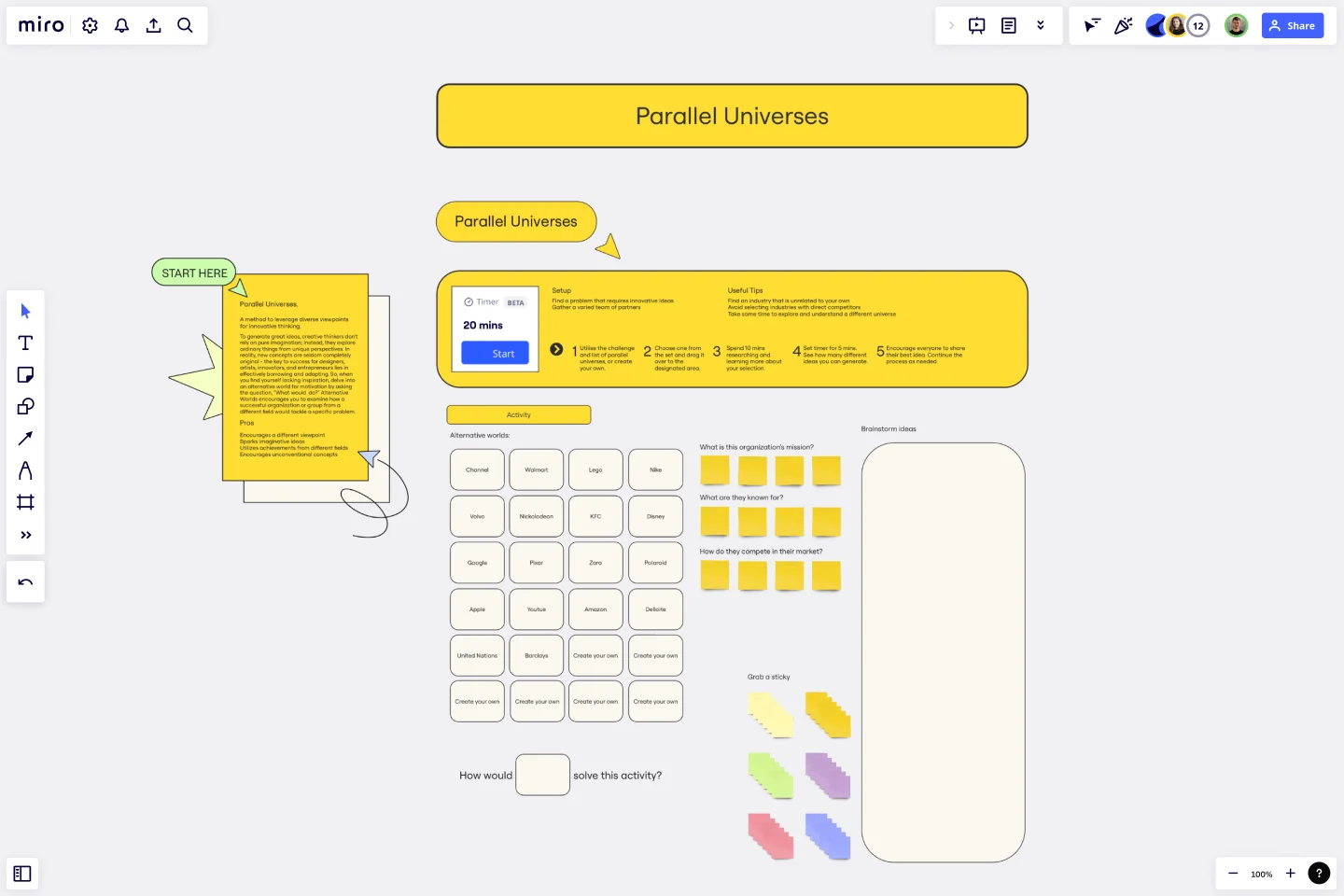Parallel Universes Template
Leverage diverse viewpoints for innovative thinking with the Parallel Universes Template.
About the Parallel Universes Template
Great ideas are not always born out of pure imagination. Creative thinkers often explore ordinary things from unique perspectives to generate innovative concepts. In reality, new ideas are seldom entirely original. The key to success for designers, artists, innovators, and entrepreneurs is effectively borrowing and adapting. Enter: Parallel Universes Template.
When you find yourself lacking inspiration, try delving into an alternative world for motivation. Ask yourself the question, "What would they do?" The Parallel Universes Template encourages you to examine how a successful organization or group from a different field would tackle a specific problem.
Benefits of using the template
Encourage a different viewpoint.
Spark imaginative ideas.
Use achievements from different fields.
Encourage unconventional concepts.
How to use the template in Miro
Use the challenge and list of parallel universes, or create your own.
Choose one from the set and drag it over to the designated area.
Spend 10 mins researching and learning more about your selection.
Set a timer for 5 mins. See how many different ideas you can generate.
Encourage everyone to share their best idea. Continue the process as needed.
Setup
Find a problem that requires innovative ideas.
Gather a varied team of partners.
Useful tips
Find an industry that is unrelated to your own.
Avoid selecting industries with direct competitors.
Take some time to explore and understand a different universe.
Get started with this template right now.
Customer Journey Map Template
Works best for:
Ideation, Mapping, Product Management
A customer journey map (CJM) is a visual representation of your customer’s experience. It allows you to capture the path that a customer follows when they buy a product, sign up for a service, or otherwise interact with your site. Most maps include a specific persona, outlines their customer experience from beginning to end, and captures the potential emotional highs and lows of interacting with the product or service. Use this template to easily create customer journey maps for projects of all kinds.
Vision Storyboard Or Narrative
Works best for:
Storyboard, Planning, Design
Craft compelling narratives with the Vision Storyboard or Narrative template. This versatile tool is perfect for developing vision statements, strategic narratives, or creative stories. It helps you outline key elements, plot progression, and visual themes, ensuring a coherent and impactful story. Use this template to align your team on the narrative vision and create a compelling storyline that resonates with your audience and stakeholders.
Storyboard for Video Production Template
Works best for:
Storyboard
The Storyboard for Video Production template is your go-to tool for planning every shot of your video project. Outline scenes, dialogues, camera angles, and visual elements to create a coherent narrative. Perfect for filmmakers, educators, or content creators, this template ensures that every aspect of your video aligns with your creative vision, streamlining production and enhancing the overall quality and impact of your project.
Empathy Map Canvas by Sampriti Jain
Works best for:
Market Research, Strategy & Planning
The Empathy Map Canvas template allows you to explore user behaviors and emotions comprehensively. It’s designed to help you visualize user experiences and create solutions that truly meet their needs. Perfect for UX teams and product developers.
Cheat Sheet Template
To ensure quick and efficient understanding and usage of a product, many products come with a reference guide or cheat sheet. Similarly, when introducing an unfamiliar concept to new audiences, a cheat sheet can effectively communicate the key principles and main features. The idea is to treat the concept as a new product and create a concise and clear reference guide that explains its intended purpose and basic specifications in a simple and straightforward manner.
Online Sketching Template
Works best for:
UX Design, Desk Research, Design Thinking
Before you go full steam ahead with a promising idea, look at it from a high level — to know how it functions and how well it meets your goals. That’s what sketches do. This template gives you a powerful remote collaboration tool for the initial stages of prototyping, whether you’re sketching out web pages and mobile apps, designing logos, or planning events. Then you can easily share your sketch with your team, and save each stage of your sketch before changing it and building on it.
